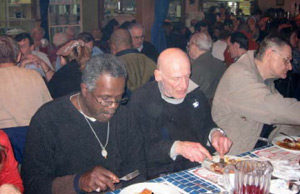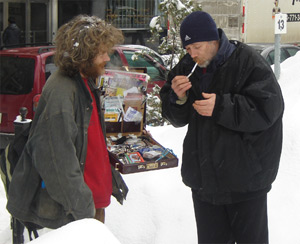|
|
In 1999, a friend of mine recounted the story of a church plant in downtown Chicago, Illinois (USA). I said to myself, “I want be a person like that!” Then in 2000 I read a book in French by Ray Bakke and Glenn Smith entitled Espoir Pour la Ville—Dieu Dans la Cité (English: Hope for the City—God in the City) in which the authors recounted similar stories in other cities. The call to a quiet life in the suburbs was not for our family. What God started in the Garden of Eden he will conclude in the celestial city spoken of in the Book of Revelation. We understood the city as a privileged blessing of God.
At the same time I was reading books on church planting and was looking for different ways to approach church plating with poor urban dwellers.1 We have launched a very different approach with the urban poor in our neighbourhood. Rather than talking about church planting, we describe our experiment as a “contribution to community development.”
Hochma: An Overview of One of Canada’s Poorest Neighbourhoods
We work in Hochelaga-Maisonneuve, better known as Hochma. If you know Hebrew, you will recognise this as a play on the word for “practical wisdom.” We have learned that the poor seek wisdom often above all else. Since Canada’s first census in 1871, Hochma has been the poorest neighbourhood of any large section of a Canadian census metropolitan area. According to Canadian urban geographer David Ley,
The deindustrialization of Montreal’s “city below the hill” has been particularly devastating. By 1986, the collapse of the economic base in the industrial southwest resulted in unemployment of over twenty percent, and demographic flight, as the population fell by one-half from its 1961 level of 107,000. A similar economic catastrophe hit the francophone waterfront neighbourhoods east of downtown, and in each instance recreational and tourist initiatives have featured prominently in redevelopment plans.
The Lachine Canal, a former industrial thoroughfare running through the heart of the southwest, has been declared a national historic park, while in the east, new tourist and leisure amenities have been constructed around the Olympic stadium. Nonetheless, these initiatives have scarcely dented the most extensive concentration of deep poverty in any Canadian inner city. East of downtown Montreal is a solid block of over twenty census tracts in acute distress where more than forty percent of persons fall below statistics of Canada’s low-income cut-off [italics mine]. Unlike the patterns in Toronto and Vancouver, Montreal’s geography of poverty remained remarkably stable throughout the 1990s.2

|
|
The broader borough has a population of 128,440 people. (The Greater Montreal area has 3.5 million people.) Our neighbourhood includes 48,735 people. Interestingly, the greater metro area is the third most densely populated area in North America with 847 people per square kilometre. It follows New York City and Boston (Massachusetts, USA). Hochma has 5,472 people per square kilometre. The neighbourhood is composed mainly French-Canadians. Only ten percent of the population are immigrants; only three percent are recent arrivals. Ninety-five percent of the residents are francophone (compare this to Montréal, which is only sixty-six percent francophone). Visible minorities comprise nine percent of the population. By every social indicator, it is a suffering area. Below are some comparisons:
|
Issue |
Hochma |
Island of Montréal |
| Single-parent families (the percentage in 1981 was 35.3%) | 51% | 33% |
| Unemployment rate | 12.8% | 9.2% |
| People living under the poverty line | 30% | 12.8% |
| Average family income | $40,364CAD | $62,409CAD |
| Rate of victimization3 | 35.6% | 26.5% |
| Rate of externalisation4 | 28 cases per 1,000 | 21 cases per 1,000 |
| Teenage pregnancy rate | 64 cases per 1,000 | 28 cases per 1,000 |
| 15-24 year olds not going to school | 49% | 31.6% |
| Juvenile delinquency rate | 78 cases per 1,000 | 61 cases per 1,000 |
| Life expectancy at birth | Men: 68.6 years Women: 76.9 years |
Men: 74.8 years Women: 81.1 years |
| Suicide mortality rate | 21 cases per 100,000 | 15 cases per 100,000 |
| Infant mortality rate | 8.9 cases per 1,000 | 5.6 cases per 1,000 |
| Avoidable mortality rate | 92 cases per 100,000 | 63 cases per 100,000 |
From the profile of the population in the borough of Hochma done by the CSSS (Family and Social Welfare Centres of Hochma, Olivier-Guimond, and Rosemont), the mortality rates in this borough for the most important causes of death are higher than any other part of Montréal. See chart below.5
|
Issue |
CSSS (rate per 100,000 people) |
Island of Montréal (rate per 100,000 people) |
| Cancer | 277 | 253 |
| Sicknesses linked to the circulatory system | 366 | 320 |
| Sicknesses linked to the respiratory system | 93 | 79 |
| Trauma, non-intentional (accidents, falls, intoxication, etc.) | 28 | 23 |
| Suicide | 21 | 15 |
During the 1990s, Hochma was the scene for an intense territorial war between two biker groups—Hell’s Angels and the Rock Machine. It was a violent battle for control of the Canadian drug trade. With the death of an innocent 7-year-old boy and a federal anti-drug law, the neighbourhood is less violent, but still very poor. ![]()
The Church in Hochma
Residents of Hochma are negative toward the institutional church.6 Because of this, we knew we could not simply use new methods—we had to have a totally different manner of thinking about how to be the people of God with the urban poor. Even using the expression “church planting” implies a certain paradigm—a meeting place, Sunday school, a way to worship, preaching, attendee figures, etc. Modern Christians think of church planting in economic terms. In our neighbourhood this will not work. We have changed our vocabulary to reflect our vision. We are using community development models and methods and want to contribute to the spiritual transformation of the neighbourhood. Our conversations with friends and neighbours start there. We seek to incarnate Jesus in our neighbourhood; we do not simply seek to bring people to God.
The marginalization of the social significance of religion and church involvement in Montréal (also defined as “secularization”) calls us to take our devotion to Christ more seriously. Spiritual formation is about empowering Christians to live their faith in the world. True Christian spirituality cannot be divorced from the struggle for justice and care for the poor and the oppressed.
The fundamental question we needed to examine is how poverty affects worldview and how worldviews can transform poverty. Poverty is a broad concept touching economic, social, physical, and spiritual realities; it affects peoples’ identity and vocation. But as Jayakumar Christian points out, the causes of poverty can be traced to “inadequacies in the worldview.”7 A worldview can be a powerful instrument in perpetuating chronic poverty.
Our mission statement translated from French reads: “We desire to establish an innovative community that pursues reconciliation with God, with others, and with ourselves in the neighbourhood of Hochelaga-Maisonneuve by Jesus Christ; a community rooted in discipleship and integral mission oriented to the re-establishment of human dignity for the most marginalized of the neighbourhood.”
We started a weekly Bible study with people in our immediate neighbourhood; our focus is on the parables of Jesus and the spiritual practices of the Christian life. We have regular conversations in local coffee shops on the weekends. During the Christmas season last year, fifty-five people came to a supper and party we organized. We launched an economic development project. With a Montreal-based Christian organization, we started a network with all the Protestants and Roman Catholic congregations to explore ways to reconnect the Church with the milieu.
God’s heart beats for the poor. God’s people are his representatives to proclaim with love the reconciliation that our culture often rejects because of its anti-institution bias. But this culture searches for authentic community. We want to offer the residents of Hochma the wisdom of God in Jesus Christ.
Endnotes
1. Rick Warren’s book The Purpose Driven Church helped me to learn that there is a big difference between planting a congregation and transplanting Christians. The book by Christian A. Schwarz, Natural Church Development, helped me understand some biotic principles of growth. These books (plus five years of professional work in Paris to help French church planters) equipped us for the work we have undertaken in Montréal.
2. Ley, David and Heather Frost. 2006. “The Inner City.” In Canadian Cities in Transition, Local Through Global Perspectives. 3rd edition. Eds. Trudi Bunting and Pierre Filion. Don Mills, Ontario, Canada: Oxford University Press, 195.
3. Victimization refers to children who have suffered from abandonment, negligence, sexual abuse, or physical abuse and are now living in youth centres.
4. Externalization refers to children who suffer from behaviour disorders or have committed a minor crime and are now living in youth centres.
5. Compilations done by Public Health of Montréal (Direction de la santé publique de Montréal) starting from an electronic file of deceased people compiled by the Department of Development of Information & Management of Information (Service de développement de l’information et la Direction de la gestion de l’information) of the Department of Family and Social Welfare (MSSS—ministère de la Santé et des Services sociaux), February 2001. Electronic.
6. The reasons for this are many and we do not have space to address them here.
7. Christian, Jayakumar. Powerless of the Poor: Towards an Alternative Kingdom of God Based on the Paradigm of Response. Ph.D thesis, Fuller Theological Seminary, Pasedena, California,USA, 340.



